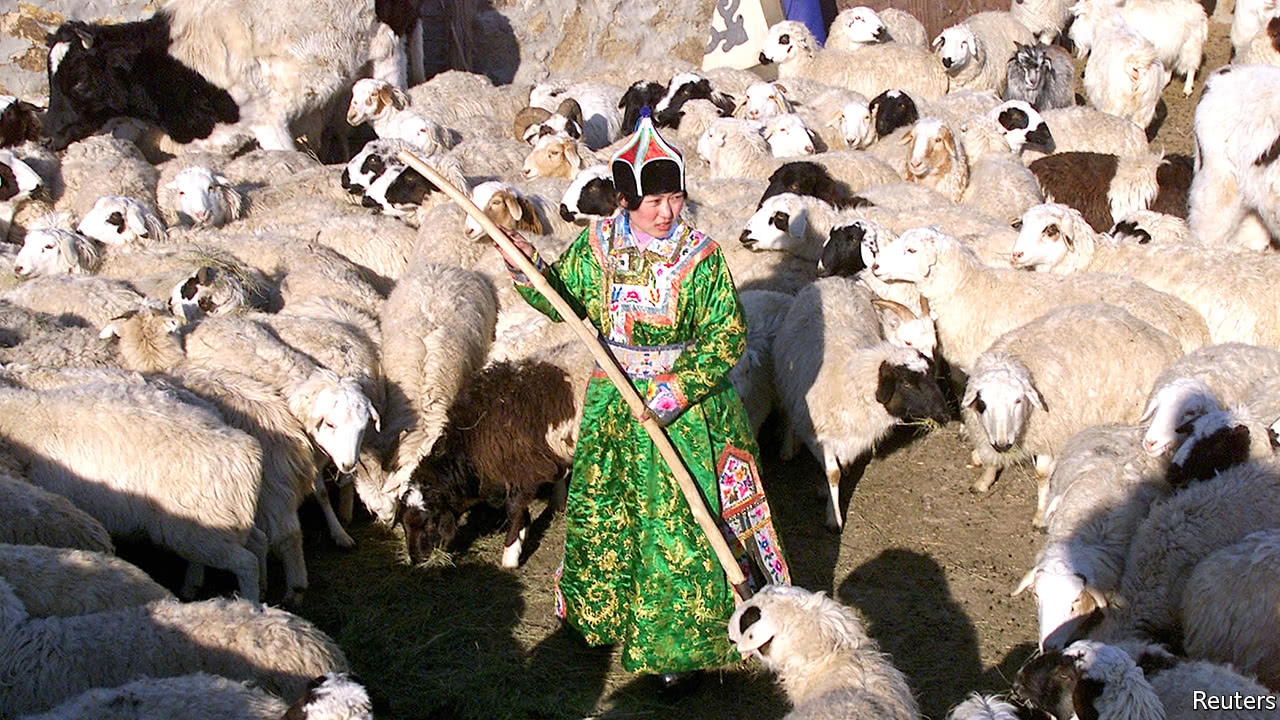In recent decades, however, the province has been largely quiescent. It does not have a separatist movement—a surprise given that Mongolia, an independent, democratic country populated by 3m people of the same ethnicity, lies just to the north. Local gripes are more often expressed in economic terms than in ethnic ones. It helps that many ethnic Mongolians are visually indistinguishable from Han Chinese, says Enze Han of the School of Oriental and African Studies in London. They are far more likely to marry a Han than minorities in western China. Many more youths leave the province to find work elsewhere too. Small wonder that the Communist Party is trying to replicate at high speed in Tibet and Xinjiang policies that have helped it subdue Inner Mongolia over many decades.
Damned if you Xanadu
Inner Mongolia’s integration is partly historical. Kublai Khan, grandson of Genghis Khan, founded a dynasty in 1271 that bound it to China. Geographical proximity to Beijing meant exchanges were frequent. Tribal divisions and the dispersal of the population hampered resistance to Chinese authority. Inner Mongolia constitutes 12% of China’s territory, but hosts less than 2% of its population.
Government policies suppressed Mongol identity. Han migration started in the 19th century. The native population was already in the minority by 1949; now only 20% of people in the province are Mongolian. The region suffered especially severe violence in the Cultural Revolution—up to 100,000 people died, by some reckonings. Buddhism, which was strongly rooted in Inner Mongolia, was crushed, and most temples destroyed. At the sprawling monastery of Da Zhao in the provincial capital of Hohhot, tourists now outnumber devotees (nevertheless, in case of problems, a SWAT team waits around the corner).
Teaching local children in Mandarin, a policy which the party is now pursuing with gusto in Tibet and Xinjiang, started early in Inner Mongolia too. All young Mongolians speak Mandarin—far fewer understand Mongolian. So comfortable is the party with the dominance of Mandarin that it has allowed Mongolian-language education to grow: the share of primary and middle-school pupils taught in Mongolian actually increased from 10% in 2005 to 13% in 2015.
Money has helped ethnic Mongolians come to terms with the Chinese Communist Party: GDP per person is $10,000 a year in Inner Mongolia, compared with $4,000 in Mongolia the country. Such riches are the result of a deliberate government strategy to exploit minerals, particularly coal, and build infrastructure (another measure repeated recently in western China).
The question is whether the model of assimilation and appeasement is sustainable. Economic pressures are growing. Many Mongolians feel excluded from the province’s overall prosperity. City folk, who are disproportionately Han, earn twice as much as herders. Even in rural areas, the energy-intensive and heavily polluting industries that fuelled the region’s boom largely benefit Han companies; few miners are Mongolian.
Mining companies show scant regard for grass or goats and consume lots of water. The water table has dropped by 100 metres in some places, according to Greenpeace, an NGO. New mines were curtailed in 2011, when a Han driver deliberately ran over and killed a Mongolian herder, sparking protests. The provincial government also soothed pastoralists with subsidies.
But Tsetseg, a 36-year-old herder near West Ujimqin, close to the scene of the killing, says most subsidies now exist in name only. Desertification and climate change mean there is less grass for her goats to graze on, so she increasingly has to buy corn as well. With rising feed costs and falling meat prices, her family has little hope of ever repaying the 100,000 yuan ($15,000) they owe. Tsetseg’s economic woes sometimes assume ethnic overtones. The area was awash with Han police after the protests in 2011, she says. She “would not agree” to her son marrying a Han: “There aren’t many Mongols now. When they marry a Han we lose them: we have to keep our bloodline.”
Bodi, who is 65, lives in a community of settled herders in Bailingmiao, an hour’s drive from Hohhot. His flat is comfortable, he says, but he hates the noise of cars, the fried (Chinese) food and eating meat raised by someone else. His neighbours, who are in their thirties, say they miss the grasslands, but their 12-year-old daughter is happy “anywhere where there is Wi-Fi”.
The government is emboldened by the area’s tranquillity. This year it is marking Inner Mongolia’s 70th anniversary as an “autonomous region” with months of “traditional” sports, music and other events. Beyond government-sponsored festivities, however, there are signs of a quiet resurgence of Mongolian identity. A 20-something in West Ujimqin whose upbringing was so Chinese that he goes by his Chinese name recently started a line of clothing adorned with local Mongolian monuments and Mongolian script that he himself cannot read. Social media have helped Mongolians from different parts of the province get in touch; Mongolian-language apps, some aimed at adults wishing to learn, are helping revive the language.
Ties with the country of Mongolia have grown too. Restaurants in Hohhot advertise chefs and singers from Mongolia. Like many Chinese-Mongolians, Bayin talks of his visit to Mongolia with awe: “Everyone there is Mongolian—even the leaders.”






 Beyond
Great Walls: Environment, Identity, and Development on the Chinese
Grasslands of Inner Mongolia
Beyond
Great Walls: Environment, Identity, and Development on the Chinese
Grasslands of Inner Mongolia China's
Pastoral Region: Sheep and Wool, Minority Nationalities, Rangeland
Degradation and Sustainable Development
China's
Pastoral Region: Sheep and Wool, Minority Nationalities, Rangeland
Degradation and Sustainable Development The
Ordos Plateau of China: An Endangered Environment (Unu Studies on
Critical Environmental Regions)
The
Ordos Plateau of China: An Endangered Environment (Unu Studies on
Critical Environmental Regions)